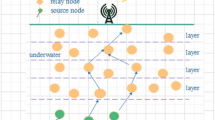Abstract
Underwater acoustic sensor networks (UASNs) play an essential role in exploring the marine world applications in rivers, ponds, and oceans. In recent years, prominent developments have addressed and resolved the numerous issues of critical underwater applications. Routing is one of the vital problems discussed widely, and various protocols are designed to solve the routing-related issues effectively. In this paper, we propose reinforcement-learning based routing using Steiner-points to minimize energy consumption and enhance the network lifetime of UASNs. Initially, the sensor nodes form a group of three nodes and calculate the Steiner point for each such group. The isolated nodes and the Steiner points in the network are vertices of the Steiner tree, which is the routing path to be constructed dynamically by the sink node agent to travel with the assistance of AUV. The sink node agent in the unknown environment initiates the Steiner tree construction process by visiting either the isolated neighbor node or neighbor sensor node’s Steiner point to collect the data from sensor nodes based on the reward function and the environmental conditions. If agent visits the isolated node, then it collects the data from that node itself. If the agent visits the Steiner point, the agent broadcasts its arrival through the beacon message and intended members of that group communicate to the agent and forwards the sensed data. The agent processes the data to remove the data’s redundancy and selects the next point to be visited and constructs the Steiner tree dynamically. The performance evaluation of the proposed scheme minimized each sensor node’s energy consumption and enhanced the network’s lifetime.












Similar content being viewed by others
References
Ayaz, M., Abdullah, A., Faye, I., & Batira, Y. (2012). An efficient dynamic addressing based routing protocol for underwater wireless sensor networks. Computer Communications, 35, 475–486.
Akyildiz, I. F., Pompili, D., & Melodia, T. (2005). Underwater acoustic sensor networks: Research challenges. Ad hoc Networks, 3(3), 257–279.
Wait, A. D. (2002). Sonar for practicing engineers (3rd ed.). Wiley.
Etter, P. C. (2013). Underwater acoustic modeling and simulation (3rd ed.). CRC Press, Taylor & Francis Group.
Khan, A., Ali, I., Ghani, A., Khan, N., Alsaqer, M., Rahman, A. U., & Mahmood, H. (2018). Routing protocols for underwater wireless sensor networks: Taxonomy-research challenges-routing strategies and future directions. Sensors, 18(5), 1–38.
Xie, P., Cui, J. H., Lao, L., & (2006). VBF: Vector-based forwarding protocol for underwater sensor networks (NETWORKING 2006). In Networking technologies, services, and protocols; performance of computer and communication networks; mobile and wireless communications systems (pp. 1216–1221). Springer.
Hwang, F. K. (1986). A linear time algorithm for full Steiner trees. Operations Research Letters, 5, 235–237.
Forster, A. (2007). Machine learning techniques applied to wireless ad-hoc networks: Guide and survey. In 2007 3rd International conference on intelligent sensors, sensor networks and information (pp. 365–370).
Kim, S. (2018). A better-performing Q-learning game-theoretic distributed routing for underwater wireless sensor networks. International Journal of Distributed Sensor Networks, 14(1), 1–12.
Faheem, M., Ngadi, M. A., & Gungor, V. C. (2019). Energy efficient multi-objective evolutionary routing scheme for reliable data gathering in Internet of underwater acoustic sensor networks. Ad Hoc Networks, 93, 101912.
Khan, A., Khan, M., Ahmed, S., Abd Rahman, M. A., & Khan, M. (2019). Energy harvesting based routing protocol for underwater sensor networks. PLoS ONE, 14(7), 1–18.
Hoa, T.-D., & Dong-Seong, K. (2019). Energy-efficient cooperative routing in underwater acoustic sensor networks. Journal of Advances in Information Technology, 10(4), 137–141.
Sangeeta, A., Kumari, P., Kumar, M., & Veena, A. (2019). Fault resilient routing based on moth flame optimization scheme for underwater wireless sensor networks. Wireless Networks, 66, 1–15.
Di Valerio, V., Petrioli, C., Pescosolido, L., & Van Der Shaar, M. (2015). A reinforcement learning-based data-link protocol for underwater acoustic communications. In WUWNET’15 proceedings of the 10th international conference on underwater networks & systems—Arlington, VA, USA (pp. 1–5).
Jin, Z., Ma, Y., Su, Y., Li, S., & Fu, X. (2017). A Q-learning-based delay-aware routing algorithm to extend the lifetime of underwater sensor networks. Sensors, 17(7), 1–15.
Ali, M., Khan, A., Mahmood, H., & Bhatti, N. (2019). An energy balanced efficient and reliable routing protocol for underwater wireless sensor networks. International Journal of Distributed Sensor Networks, 15(6), 1–11.
Wadud, Z., Ismail, M., Qazi, A. B., Khan, F. A., Derhab, A., Ahmad, I., & Ahmad, A. M. (2019). Cooperative, reliable, and stability-aware routing for underwater wireless sensor networks. IEEE Access, 7, 175980–175999.
Kumari, S., Mishra, P. K., & Anand, A. (2019). Integrated load balancing and void healing routing with Cuckoo search optimization scheme for underwater wireless sensor networks. Wireless Personal Communications, 66, 1–17.
Jin, Z., Zhao, Q., & Yishan, S. (2019). RCAR: A reinforcement-learning-based routing protocol for congestion-avoided underwater acoustic sensor networks. IEEE Sensors Journal, 19(22), 10881–10891.
Han, G., Du, J., Lin, C., Wu, H., & Guizani, M. (2020). An energy-balanced trust cloud migration scheme for underwater acoustic sensor networks. IEEE Transactions on Wireless Communications, 19(3), 1636–1649.
Tiansi, H., & Yunsi, F. (2008). QELAR: A Q-learning-based energy-efficient and lifetime-aware routing protocol for underwater sensor networks. In 2008 IEEE international performance, computing and communications conference (pp. 247–255).
Yuan, Z., Tao, C., & Wei, X. (2020). Anypath routing protocol design via Q-learning for underwater sensor networks. IEEE Internet Things Journal, 47, 1–16.
Winter, P., & Zachariasen, M. (1997). Large Euclidean Steiner minimum trees in an hour. ISMP.
Kalinin, M. I., & Kononogov, S. A. (2005). Boltzmann’s constant, the energy meaning of temperature, and thermodynamic Ir-reversibility. Measurement Techniques, 48, 632–636.
Funding
Not applicable
Author information
Authors and Affiliations
Corresponding author
Ethics declarations
Conflict of interest
The authors declare that they have no conflict of interest.
Additional information
Publisher's Note
Springer Nature remains neutral with regard to jurisdictional claims in published maps and institutional affiliations.
Rights and permissions
About this article
Cite this article
Halakarnimath, B.S., Sutagundar, A.V. Reinforcement Learning-Based Routing in Underwater Acoustic Sensor Networks. Wireless Pers Commun 120, 419–446 (2021). https://doi.org/10.1007/s11277-021-08467-3
Accepted:
Published:
Issue Date:
DOI: https://doi.org/10.1007/s11277-021-08467-3




